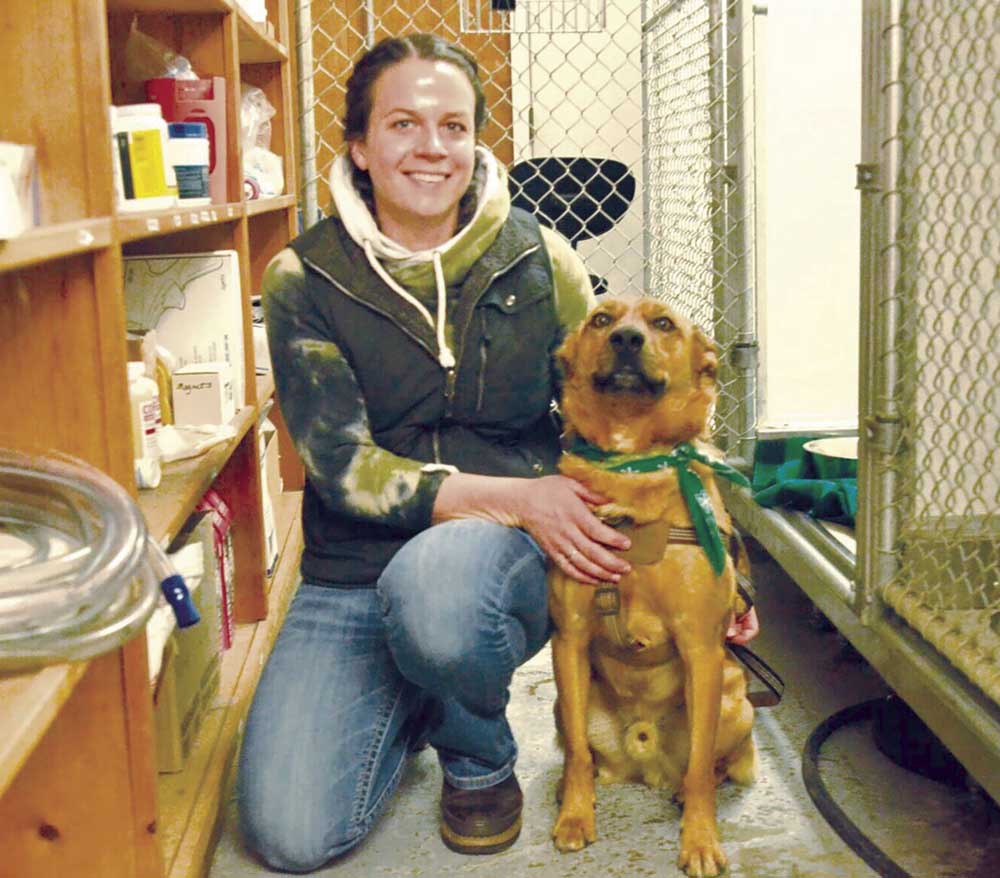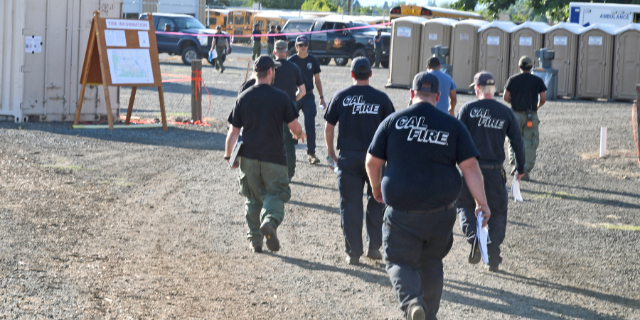‘We’re in it for the animals:’ Women veterinarians reflect on challenges, rewards
Published 6:00 am Wednesday, November 1, 2023

- Dr. Chrissie Younggren sits with her dog, River, at Enterprise Animal Hospital in December 2021, not long after she joined the practice.
ENTERPRISE — As the big, black Labrador lay sedated on the operating table, machines monitoring his breathing and heart rate, Dr. Kala Grover worked to save his leg, the injury the result of an unfortunate encounter with a car. His other hind leg showed several patches of bare skin due to road rash from the same accident.
Trending
Grover was about to attach a skin graft as part of the orthopedic procedure to save the leg.
Wallowa County has seven veterinarians, four of whom are women. They represent a growing trend in veterinary medicine — the application and acceptance of more women than men to veterinary schools, and thus more women working in the field.
According to Washington State University College of Veterinary Medicine Dean Dori Borjesson, the primary reason students go into veterinary medicine is “compassion for animals. (They) want to be a voice” for animals.
Trending
At every college nationally, she said, women outnumber men in applying to veterinary schools by an 80-20% margin. She said there are a couple of reasons for this.
“First, it is a caring profession,” she said, and it’s a STEM field (science, technology, engineering and math) that attracts women and “aligns with their compassion.”
Three female veterinarians in Wallowa County — Kala Grover, Kim Layne, and Chrissie Younggren — work at the Enterprise Animal Hospital. The fourth, Brooke Greenshields, works at Double Arrow Veterinary Clinic PC. All women cite their love of animals and the desire to help them as the primary reason for becoming a veterinarian.
None of them, they will tell you, are in it for the money.
Ironically, despite the uptick in women in veterinary medicine, a recent ABC News story reported that there is a nationwide shortage of veterans. One reason why is that pet ownership went up during the pandemic.
Borjesson confirmed the nationwide shortage, but noted that schools can only move so fast in educating and training veterinarians.
In addition, the news story cited a high rate of burnout, with 1 in 6 veterinarians and 1 in 4 technicians citing it as a contributing factor for leaving the profession, along with high student loan debt and abuse from clients over the high cost of veterinary care. The suicide rate among vets is also among the highest compared to other professions.
Origin storiesEach of the Wallowa County women vets has a different story behind how and why they entered the profession, but all have a similar theme — love of animals and the desire to help them live long, healthy lives.
Greenshields always wanted to be a veterinarian.
“I never wanted to be anything else,” she said.
Since her father is also a veterinarian at Double Arrow, she said she spent a lot of her childhood at the clinic. Greenshields attended Oregon State University’s College of Veterinary Medicine and has worked at Double Arrow for three years.
Grover decided when she was very young that a career in veterinary medicine was the career path she would pursue. She said she watched a veterinarian do a Caesarean section on a cow in her barn and, “I was hooked.” Grover earned her doctorate from Ross University and did clinical studies at Oregon State University.
Younggren grew up in Island City and went to career days at the animal clinics. “As far as I can remember, I always wanted to be a vet. I enjoy animals,” she said.
She attended the College of Idaho, Ross University and did clinical work at Oregon State University.
Layne attended Cornell University as an undergraduate and attended Washington State University’s School of Veterinary Medicine.
The rewards and challenges are numerous, the women said. Layne cites one of the big rewards for her is “the difficult cases” and helping out clients and their animals is a “big reward. I like to work with people.”
She said she enjoys talking with ranchers and helping them keep their animals healthy.
Working with geriatric pets is one of Younggren’s rewards. She said she is dedicated to giving those pets a good quality of life.
For Grover one of the rewards is taking on “the train wrecks. I enjoy the challenge of fixing things. I enjoy coming to work and feel like I’m making a difference.”
Greenshields said for her the support she gets from her dad and the other members of the clinic staff is rewarding. “(This is a) really rewarding job. I have immense support. My dad, Dr. Randy Greenshields, and Dr. Dave Shaefer — the whole clinic — are a great support system. Everybody is great. I get to do a little of everything.”
Money challenges
On the flip side are the challenges. Layne cites clients who seem to feel the veterinarians are only doing it for the money.
Grover and Younggren agreed.
“People think as vets, we should be doing it out of the goodness of our hearts. But it’s also my job and I have to feed my family,” Grover said.
Younggren said she wants people to know that their vets really care for their animals and are not just charging them high prices and ordering expensive tests because they want to.
“We’re in it for the animals,” she said.
Borjesson mentioned “compassion fatigue” as a challenge for veterinarians. In addition is the euthanasia part, when a beloved pet must be put to sleep, along with moments when clients are not kind and patient with vets on occasions when the client cannot afford the care their pets need.
Layne added it is also hard when an animal being treated doesn’t make it.
As with many things, inflation plays a part and costs have gone up along with everything else — equipment costs more, medications cost more and labor costs factor in. Some equipment used in a vet clinic can carry a price tag as high as $50,000.
Another challenge faced by the women is student debt, and a debt-to-income ratio. Human doctors make more money than veterinarians, yet veterinarians can graduate from vet school with a student debt load of an estimated $250,000-$600,000. Grover said there are no programs to help with reducing that debt as there are for teachers or medical doctors. Younggren said the financial burden “weighs on me.”
According to www.money.usnews.com, the median salary in 2021 for a veterinarian in the United States was $100,370. The best-paid made $128,410 that year while the lowest paid made $78,920. There are many factors that go into salary figures including location — some areas of the country cost more to live in — specialty, and whether vets own their own practices.
The hours are long and the effort it takes to maintain a work-life balance is another challenge cited by the women.
“Burnout is a huge problem in the vet industry,” Grover said. She has two children and said child care is hard to find in the county. “My kids spend a lot of time in the clinic,” she said.
Depression also occurs frequently among veterinarians. It is hard when someone’s pet must be euthanized. Younggren said she won’t tell an owner when it’s time to let their pet go but supports the decision when owners decide to euthanize their pets.
Other challenges include clinics that are understaffed, the difficulty in retaining receptionists and technicians and clinics that cannot afford to offer benefits. Many technicians are part-time.
Wallowa County is fortunate in that it has veterinarians who are “on call” and willing to go out to help an animal that needs them, no matter what time of the day or night. Large, urban areas usually have patients go to emergency veterinarians, which cost more.
Fighting for acceptance
Sometimes acceptance is an issue — getting clients to trust a woman to treat their pet or livestock.
For Greenshields, the challenge was a little different. She said she was “the kid coming back” from OSU to practice in Wallowa County, whee everyone knew her when she was growing up.
Nowadays, she said, she enjoys working a lot in the cattle side of the practice, but it can be challenging. It’s hard to find veterinarians willing to work with cattle, which is a current trend in veterinary medicine, she said. There were few students in her class who were interested in that area; they were mainly interested in small animal — dog and cat — veterinary medicine.
The women gave various reasons why their industry has seen an increase in women over men in the past several decades. Layne said it may have something to do with girls and women being more encouraged to enter fields that were previously more male-dominated.
Given the rewards and challenges of their field, would they recommend it as a career path for women?
“Definitely,” said Greenshields. “I really love this job. It’s really rewarding.” But she added that it’s a career that requires a “big commitment,” and advised women to think carefully about the decision.
Younggren advised women considering veterinary medicine to ask themselves the question if “there is something else you’d enjoy just as much doing the rest of your life.” But if they can’t see themselves doing anything else, then they should explore the profession.
Borjesson noted that the profession offers opportunities other than practice: For example, she said, a vet could go into research or academics.
Vets are “well-respected individuals,” she said. “Most people love their vet. The opportunities and rewards are endless.”
The profession is “amazing … (I have) no hesitation in recommending the profession. (It’s) a great community to be in,” Borjesson said.
And the patient whose leg Grover was working to save? At the time of this writing, he will go on to have many more years of running and playing.
On all four legs.









